When I was growing up, my family made fun of me for being a carnivore. I'll admit, back in days I was all about the meat - chicken, pork, beef, lamb, you name it! But at some point, I really started enjoying eating veggies too. Now it feels odd when I eat a meal without veggies! That's why one of my fave Chinese take out menu items is Moo Goo Gai Pan. It's one of the healthier options - Chicken with mushrooms and other veggies!.
What's Moo Goo Gai Pan?
By the way, I was super confused when I first heard of this dish. I was like this is just gibberish right? I speak Mandarin Chinese fluently, and those words mean nothing to me. Turns out it is actually in Cantonese, and once I realized it, I can totally see how the words match - the Chinese characters are 蘑菇雞片.
- Moo Goo = 蘑菇 = Button Mushroom
- Gai Pan = 雞片= Chicken slices
Direct translation! How fun!
So basically Moo Goo Gai Pan is Chicken and Mushrooms Stir Fry! Normally it is also served with a variety of other veggies besides mushrooms too.
Is Moo Goo Gai Pan healthy?
I can't promise that every Moo Goo Gai Pan you order is going to be healthy, but this recipe is healthy considering it's made with chicken breast, and an assortment of healthy vegetables!
Also, my marinade and sauce is simple, but makes the dish flavorful and delicious!
If you're ordering out, they could add MSG, or other unhealthy ingredients, but I'm thinking if you're eating Chinese takeout you can't really expect to be able to eat super healthy and Moo Goo Gai Pan is probably one of the healthier options available (compared to General Tso's or Sesame Chicken, etc.).
Gluten Free Option – Tamari!
A note about the gluten free method of making this, it’s all about the the soy sauce substitute. Let me introduce… Tamari! In short, there are actually many different types of soy sauce in Asia. My mom constantly has at least 2 different types in the kitchen pantry. For example, when we are using soy sauce for dipping, we use Light Soy Sauce (Thin Soy Sauce), and if we are cooking we will sometimes Dark Soy Sauce.
Well, Tamari is another kind! It is made as a byproduct of making miso. It has a rich color and flavor and is thicker than your standard soy sauce. Authentic tamari will contain very little to no wheat, making it suitable for gluten-free diets. However, always check your tamari to make sure it is 100% gluten free if you are on a gluten free diet.
To be honest, you can make this without tamari or soy sauce too, but it does help flavor the chicken.
Ingredients
- ¾ pound of boneless skinless chicken breasts, sliced
- 1 tablespoon soy sauce or tamari (use Tamari if gluten free)
- 2 tablespoon cooking oil, separated by tbsp
- 1 tablespoon + 2 teaspoon corn starch, separated
- 2 tablespoon of water
- 2 teaspoons minced garlic
- 2 cups of sliced mushrooms (8 oz)
- 1 cup of snow peas (4 oz)
- 2 cups napa cabbage, cut in 1 inch pieces
- 8-oz can of sliced water chestnuts, drained
- Salt, as desired
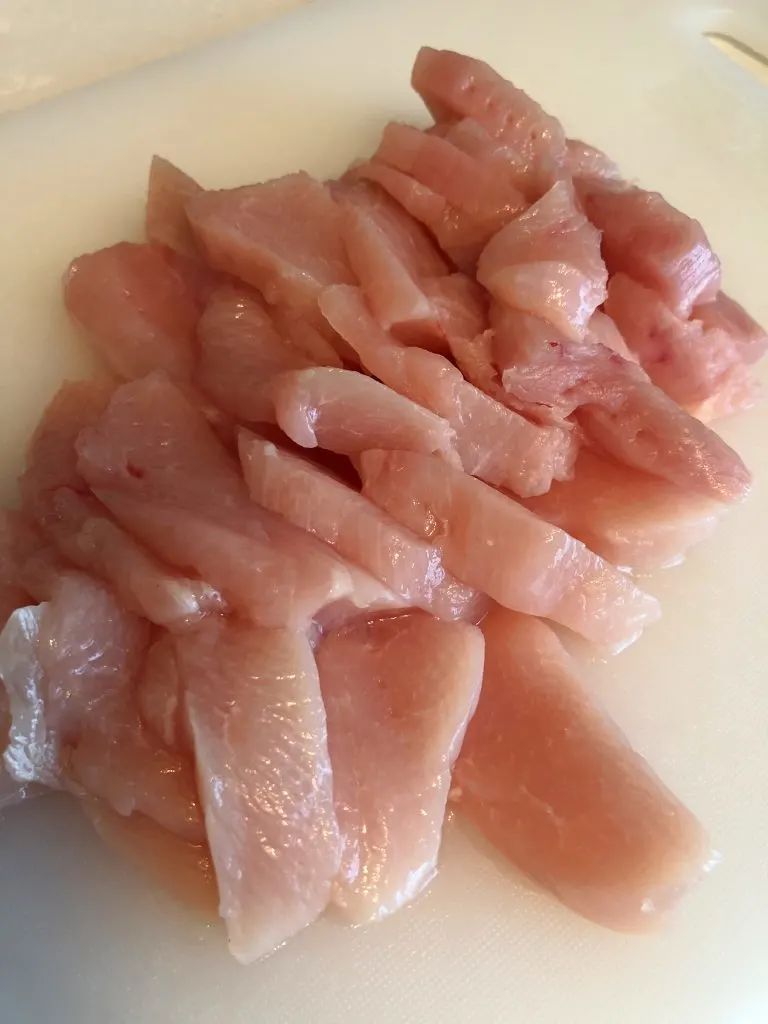
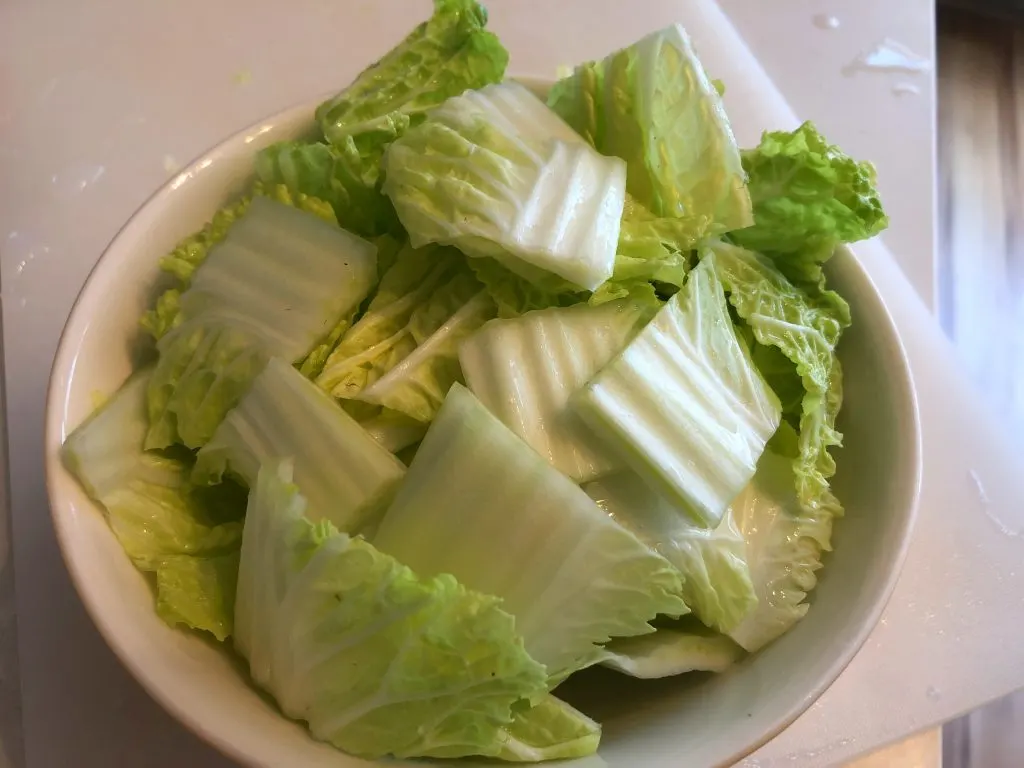
INSTRUCTIONS
In a bowl, add 1 tablespoon cornstarch, 1 tablespoon soy sauce or tamari, and 1 tablespoon of cooking oil. Add sliced chicken in to bowl and toss to coat. Place aside for about 30 minutes.
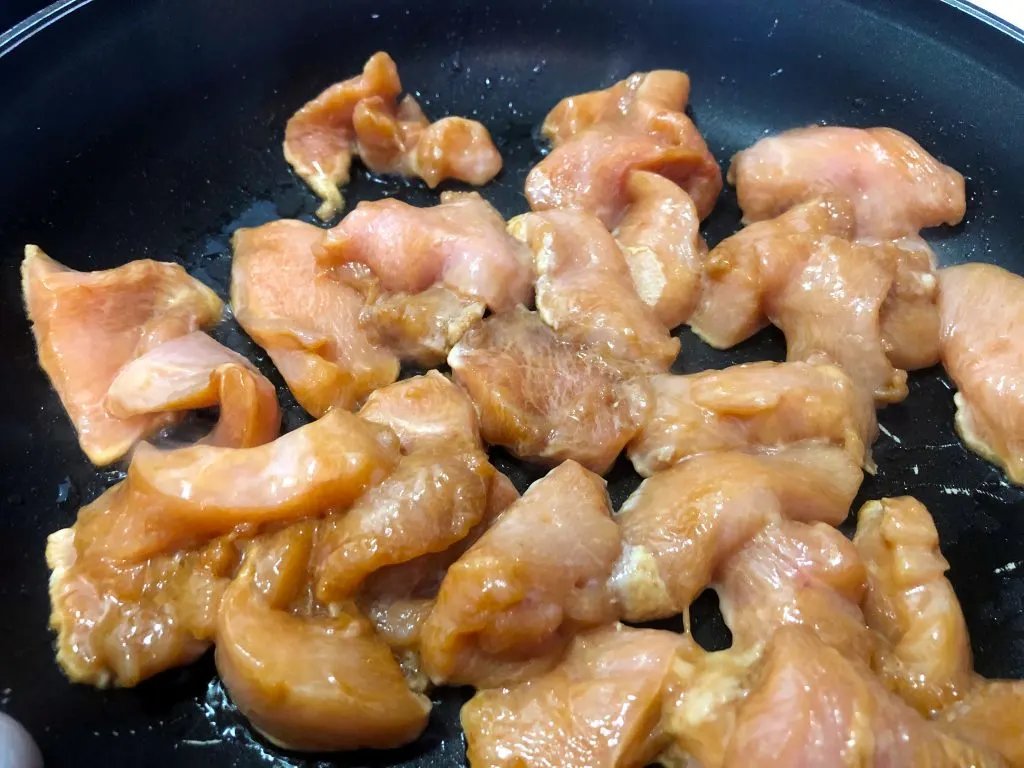
While we wait for that, chop up the veggies if you haven't already. Also, go ahead and in a small bowl, whisk in 2 tablespoon of water with 2 teaspoon of cornstarch. Set that aside for later.
In a large non stick cooking pan or wok, add a tablespoon of cooking oil, and heat on high. Add chicken to pan, and stir fry for just about 30 seconds or until it turns opaque. It should be just about fully cooked but not really. We want to avoid over cooking it as we are going to add it back to the pan later. Remove from heat.
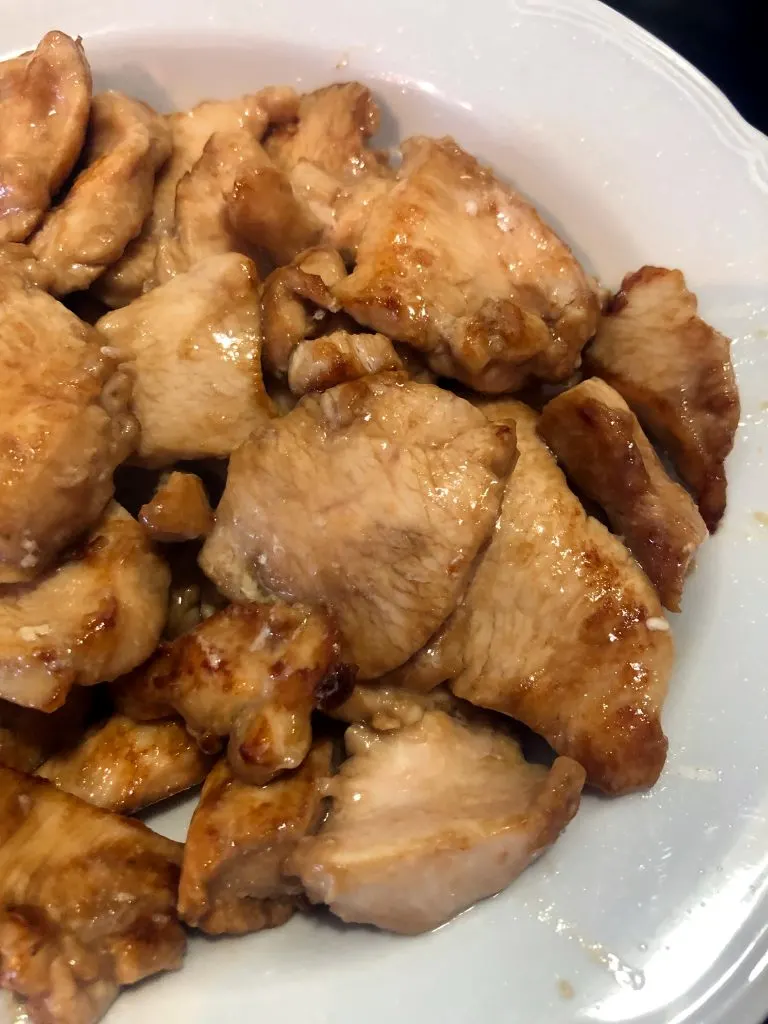
Bump down the heat to medium, and add another tablespoon of cooking oil, along with minced garlic.
Add napa cabbage, and stir fry for a minute, and then add mushrooms. Let it cook stirring occasionally for about 2-3 minutes. If the pan is too dry, add a splash of water.
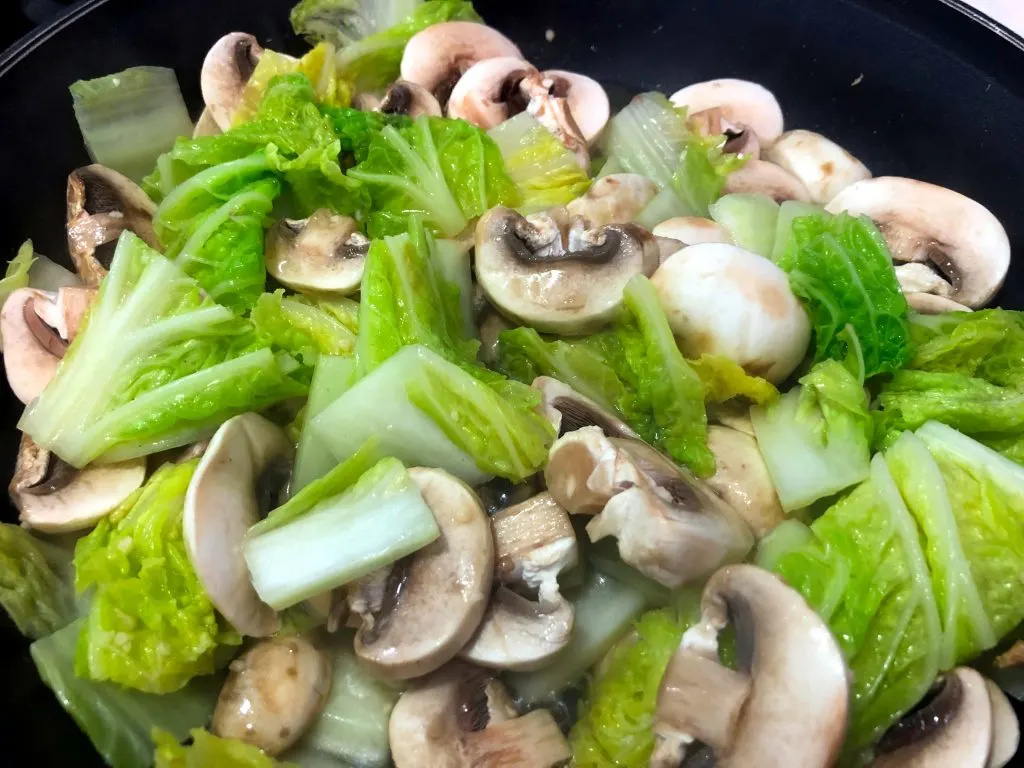
Add water chestnuts and snow peas and let it cook for another 1-2 minutes until the snow peas are bright green.
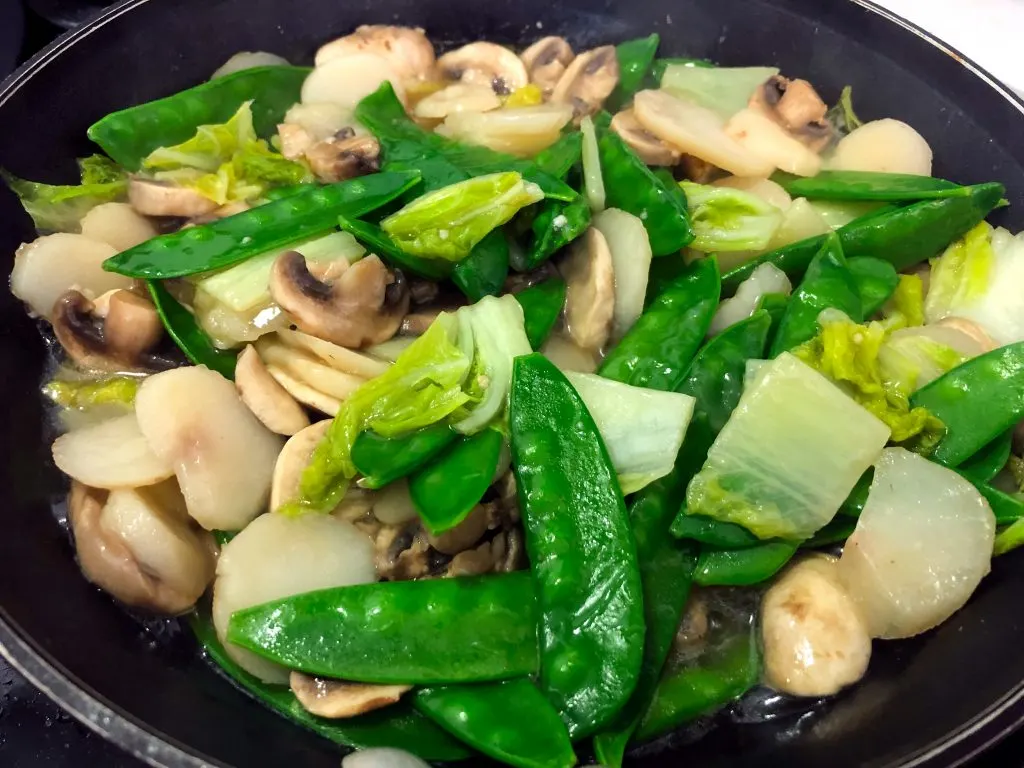
Add the chicken back in to the pan, cornstarch mixture we made earlier, and salt as desired, and let everything cook until tender and cooked thoroughly.
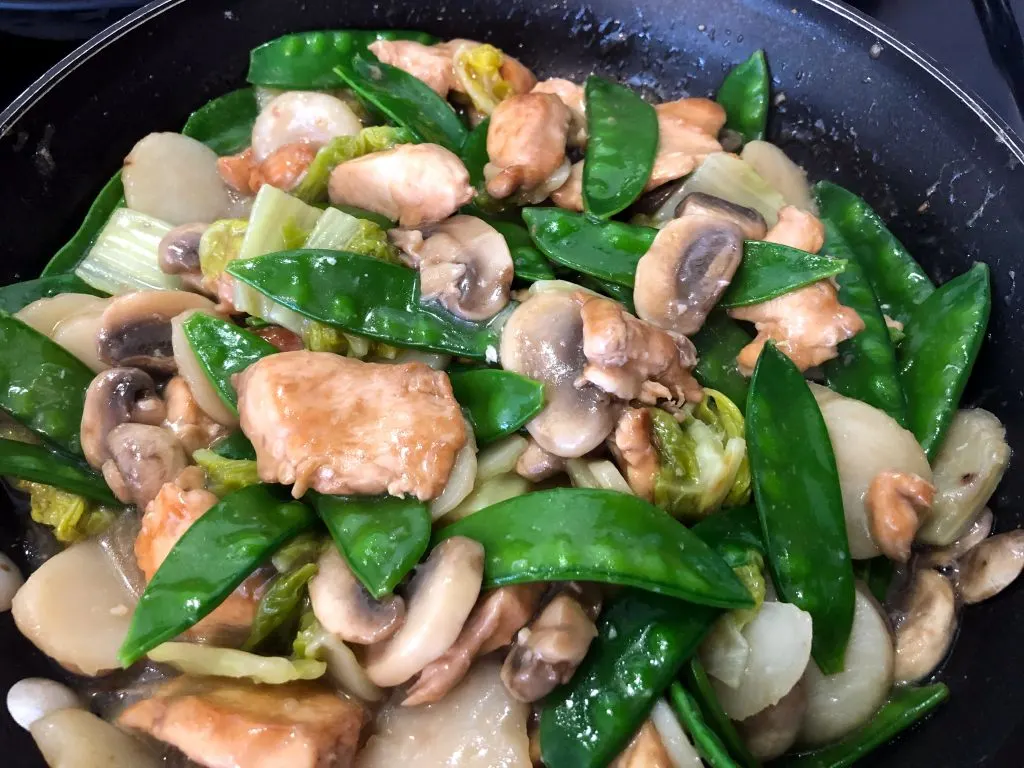
Remove from heat and serve!
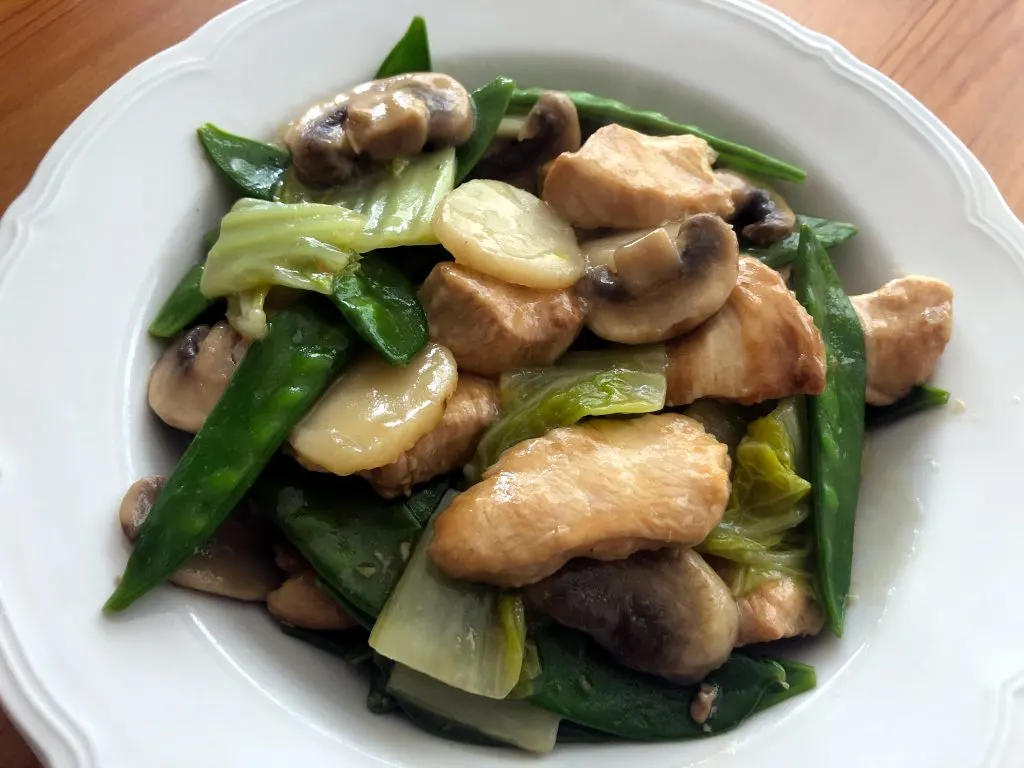
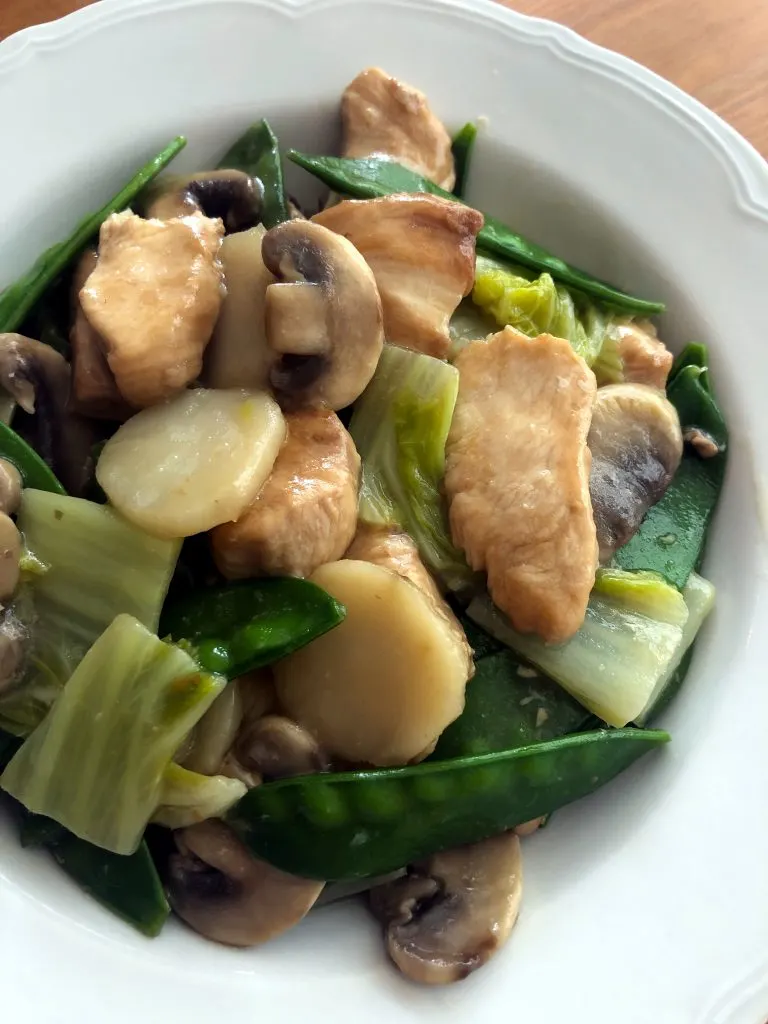
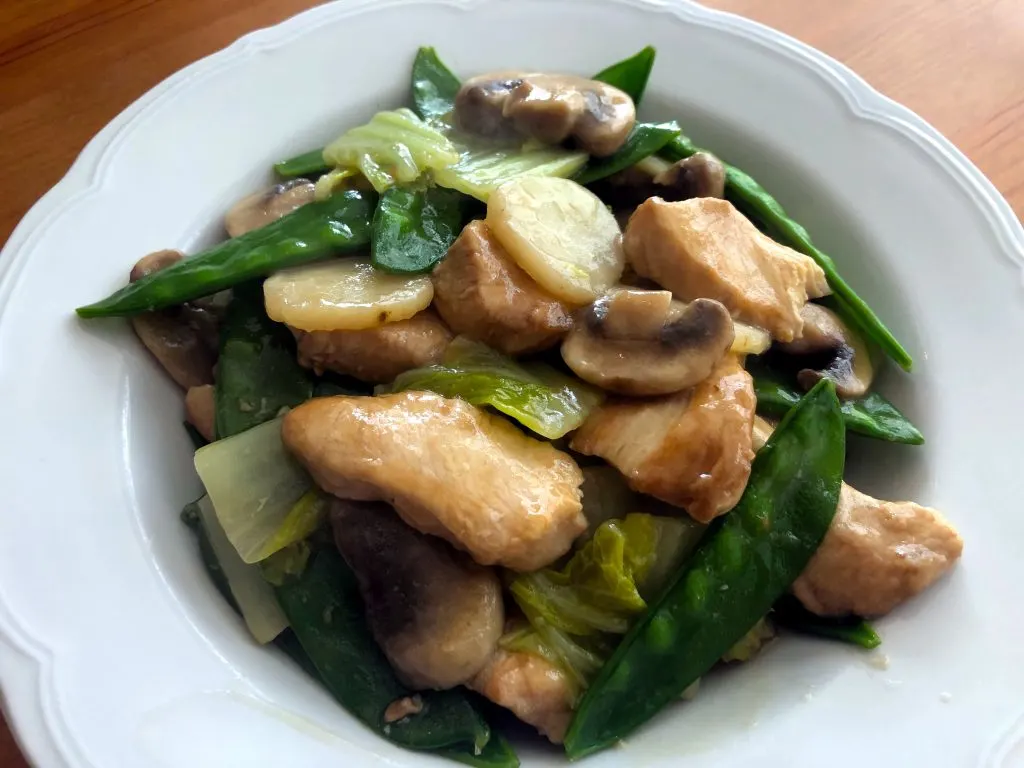
Moo Goo Gai Pan
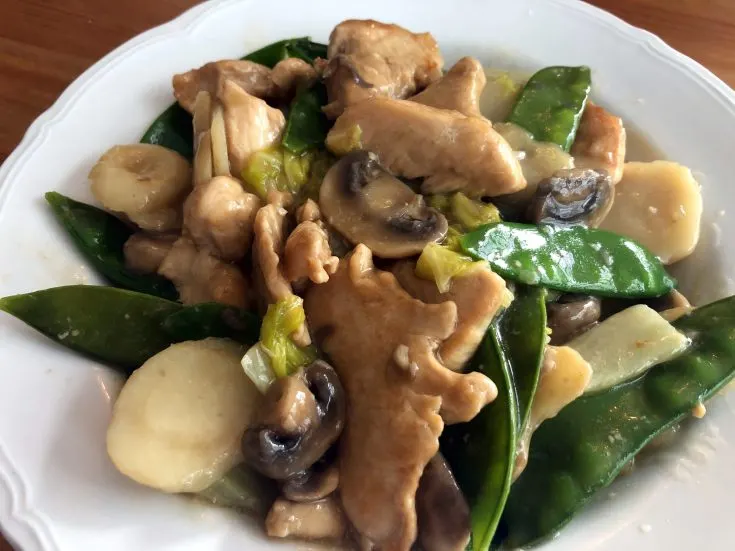
Moo Goo Gai Pan - Marinated sliced chicken stir fried with mushrooms, snow peas, napa cabbage and water chestnuts in a tasty white sauce.
Ingredients
- ¾ pound of boneless skinless chicken breasts, sliced
- 1 tablespoon soy sauce or tamari (use Tamari if gluten free)
- 2 tablespoon cooking oil, separated by tbsp
- 1 tablespoon + 2 teaspoon corn starch, separated
- 2 tablespoon of water
- 2 teaspoons minced garlic
- 2 cups of sliced mushrooms (8 oz)
- 1 cup of snow peas (4 oz)
- 2 cups napa cabbage, cut in 1 inch pieces
- 8-oz can of sliced water chestnuts, drained
- Salt, as desired
Instructions
- In a bowl, add 1 tablespoon cornstarch, 1 tablespoon soy sauce, and 1 tablespoon of cooking oil. Add sliced chicken in to bowl and toss to coat. Place aside for about 30 minutes.
- While we wait for that, chop up the veggies if you haven’t already. Also, go ahead and in a small bowl, whisk in 2 tablespoon of water with 2 teaspoon of cornstarch. Set that aside for later.
- In a large non stick cooking pan or wok, add a tablespoon of cooking oil, and heat on high. Add chicken to pan, and stir fry for just about 30 seconds or until it turns opaque. It should be just about fully cooked but not really. We want to avoid over cooking it as we are going to add it back to the pan later. Remove from heat.
- Bump down the heat to medium, and add another tablespoon of cooking oil, along with minced garlic.
- Add napa cabbage, and stir fry for a minute, and then add mushrooms. Let it cook stirring occasionally for about 2-3 minutes. If the pan is too dry, add a splash of water.
- Add water chestnuts and snow peas and let it cook for another 1-2 minutes until the snow peas are bright green.
- Add the chicken back in to the pan, cornstarch mixture we made earlier, and salt as desired, and let everything cook until tender and cooked thoroughly.
- Remove from heat and serve!
Nutrition Information:
Yield:
4Serving Size:
1Amount Per Serving: Calories: 275Total Fat: 11gSaturated Fat: 1gTrans Fat: 0gUnsaturated Fat: 8gCholesterol: 72mgSodium: 457mgCarbohydrates: 14gFiber: 4gSugar: 4gProtein: 31g
The nutrition information for this recipe is an approximate total per serving. Please double check the nutrition information for your exact ingredients and brands for more precise nutrition information.
Pin for later!
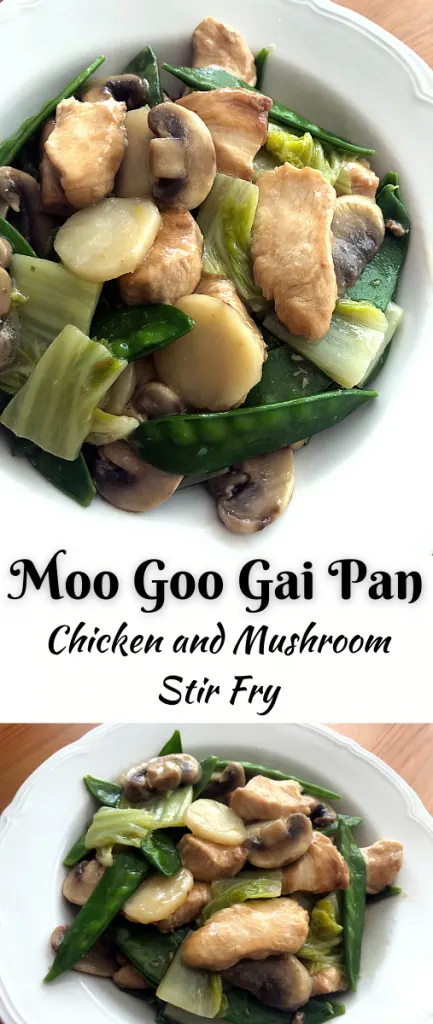
Looking for more delicious Chinese recipes like this Moo Goo Gai Pan? Look no further! You can find all my Chinese recipes here!
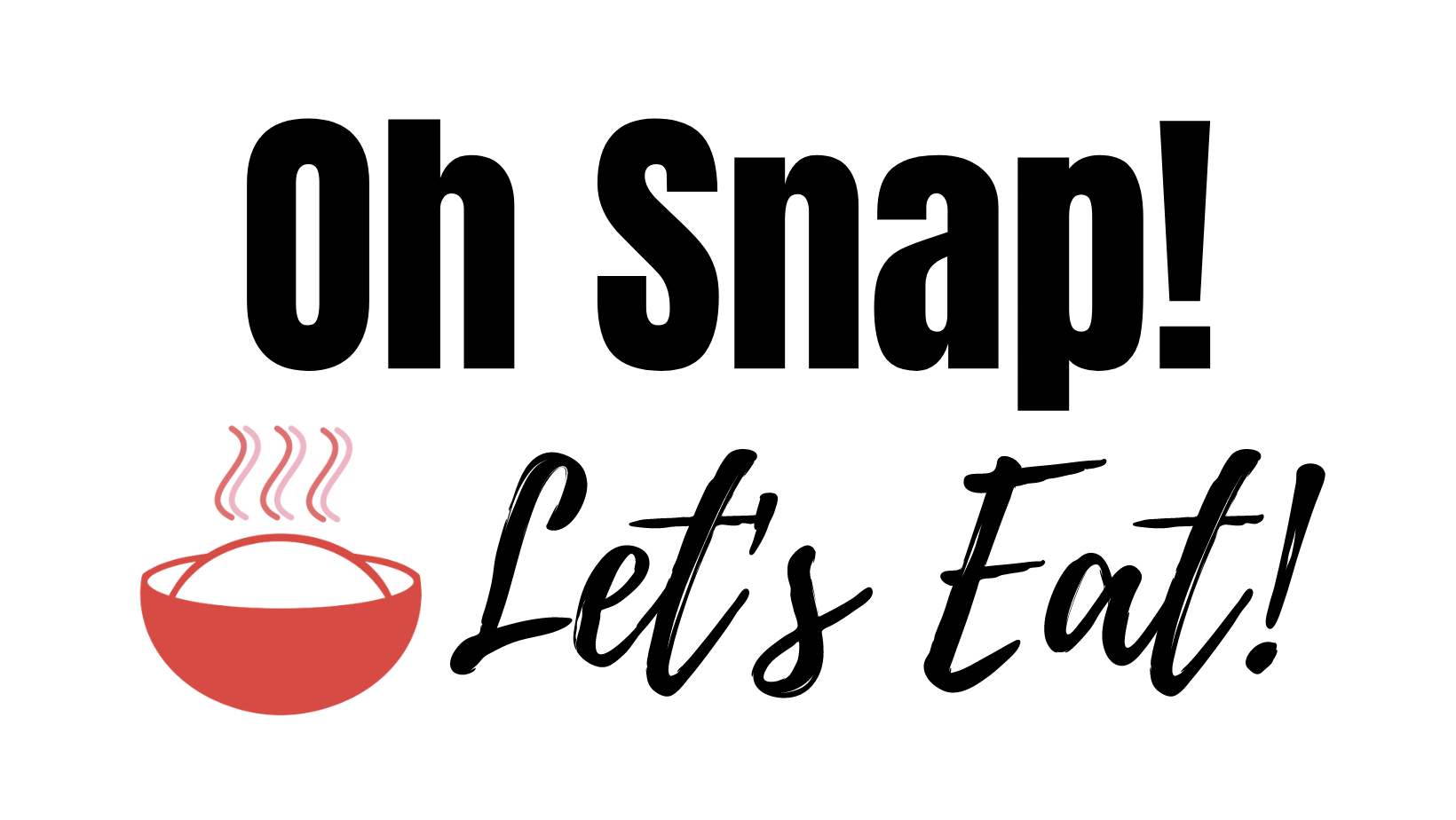
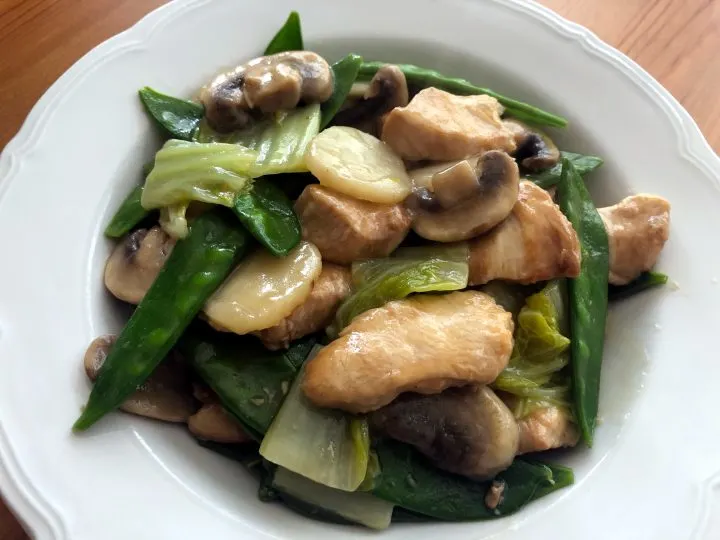
Willie C Equila
Wednesday 22nd of March 2023
First tasted this in South Carolina loved it and always order it for dinner in Frankfurt Germany. Came back to Hawaii tried ordering it but was disappointed because they never heard of this recipe. Thank you for sharing now I can make it myself.
TinaTsai
Wednesday 22nd of March 2023
I hope you enjoy it!! :D
Duncan Edwards
Saturday 10th of July 2021
#an exceptionaldelicious and healthy entree😛
Sharon
Wednesday 9th of September 2020
I dong understand the instructions for the cornstarch - can you please clarify?
Russell Watts
Sunday 16th of October 2022
@tinatsai, You missed listing the water in the ingredients and it does not say what the 2 teaspoons of cornstarch are mixed with in the directions
tinatsai
Wednesday 9th of September 2020
Hi there! There are two different uses for the cornstarch for this recipe - the first is to mix it with the chicken marinade first (Step 1) This makes the chicken slices more tender when you cook them. The second is to use it as a thickener. For example, lots of American dishes will have you add flour as a thickener in sauces, but for Chinese dishes, we often use Cornstarch. So in Step 2, we mix the cornstarch with water to create a thickener, and then in step 7 we add that cornstarch thickener in the dish to thicken the sauce. Does that answer your question?